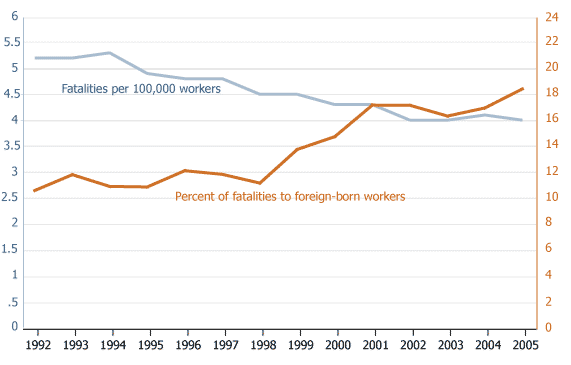Eric Zuehlke
Former Web Communications Manager

October 30, 2009
Former Web Communications Manager
(November 2009) Every year, thousands of workers are injured or die on the job from preventable accidents in the United States. Immigrants, especially Hispanics, are disproportionately exposed to dangerous jobs. The occupational fatality rate for Hispanics has been the highest among all groups in the United States for 15 years.1 According to the Bureau of Labor Statistics, even though Hispanic workplace deaths decreased from 937 in 2007 to 774 in 2008, the fatal injury rate for Hispanics remain higher at 4.0 deaths per 100,000 workers than for blacks and whites (3.5 and 3.7, respectively).2
However, despite public perception and anecdotal evidence, previous research examining data from the 1980s and early 1990s concluded that immigrants were less likely to work in risky jobs than U.S.-born workers. Now, a new study by Pia M. Orrenius and Madeline Zavodny in Demography finds that immigrants are more likely to work in risky jobs than U.S.-born workers. Using data from the 2003-2005 American Community Survey and the Bureau of Labor Statistics on work-related injures and fatalities, the authors conclude that immigrants work disproportionately in more dangerous industries and occupations than U.S.-born Americans.3
While the overall fatality rate for workers in the United States steadily declined between 1992 and 2005, the fatality rate for foreign-born workers increased from 1998 to 2005 (see figure). According to Orrenius and Zavodny’s research, there was an average of 5,691 work-related deaths annually between 2003 and 2005. Mining, logging, agriculture, and construction are among the riskiest occupational sectors in the United States, and have high levels of immigrant workers. Foreign-born workers make up 15 percent of the U.S. labor force but they account for 18 percent of on-the-job fatalities. Occupational hazards are not the only risks to immigrants on the job. According to Orrenius and Zavodny, over 3,000 foreign-born workers were murdered at work between 1992 and 2005, making homicide the leading cause of workplace fatalities among immigrants.4

Source: Pia M. Orrenius and Madeline Zavodny, “Do Immigrants Work in Riskier Jobs?” Demography 46, no. 3 (2009): 539.
Workplace injury for immigrants may be underreported. According to the National Council of La Raza (NCLR), Hispanic workers are concentrated in small businesses and other work environments where job-related injuries tend to be underreported, making the full scope of the problem difficult to assess. Orrenius and Zavodny give several reasons for the underreporting: Workers may be hesitant to report injuries or illness to their employers out of fear of losing their jobs; workers may not be able to afford time away from work; or employers may not track all injuries and illnesses to avoid inspection and compensation.
Work-related deaths affect Hispanic families especially hard. Life insurance, which provides income to families and dependants, is more common in jobs that tend to have lower participation by Hispanic workers—management and professional jobs or jobs in the public sector for example. Jobs with higher concentrations of Hispanic workers such as service jobs, construction, and maintenance typically do not offer life insurance, leaving Hispanic families especially vulnerable.5
It is not clear why immigrants take on riskier jobs, although the lack of legal status of some immigrants, lower English ability, less education, and fewer job opportunities all play a role. “Previous research suggests that Mexican immigrants do not receive higher pay in exchange for working in riskier jobs,” says Zevodny. “This suggests [they] may have limited options in the labor market, perhaps because of limited English-speaking abilities or a lack of legal status.”
Those with lower English ability and less time in the United States are more likely to work in risky jobs. “There is some evidence that immigrants who have been in the United States longer tend to work in safe jobs,” says Orrenius. “This can be due to several factors that improve over time, such as skill acquisition, including English skills, knowledge of U.S. labor markets, extent of networks and connections, and likelihood of having legal status.”
Cultural factors also play a role. Different perceptions or knowledge of job risks may lead immigrants toward riskier jobs since U.S. job conditions are seen as safer than those in developing countries. Lower levels of education and English-language ability may account for immigrants having less information about job risks and having fewer job options. Posting occupational safety instructions in languages other than English would help mitigate job-related injuries and deaths, but would not completely address the problem. It is estimated that about 750,000 immigrants (2.5 percent of the adult foreign-born population) are illiterate.
Despite an overall decline in job-related deaths in recent years, foreign-born workers continue to work in riskier jobs than U.S.-born Americans. Orrenius and Zavodny estimate that there are over 320 excess deaths and 61,720 excess injuries per year for immigrant workers. These estimates assume that fatality and injury rates are equal for U.S.-born Americans and immigrants within industries and occupations, and may underestimate the true risk of workplace injury borne by the foreign-born. More research is needed to understand the full extent of the difference for immigrant and U.S.-born workers in the United States
According to Zavodny, the extent of the impact of immigration on working conditions is still unclear. “We think the big unanswered question is whether immigration affects working conditions. As more immigrants come, do working conditions worsen for everyone, both immigrants and native-born, because there are more people competing for jobs?”
Eric Zuehlke is an editor at the Population Reference Bureau.
